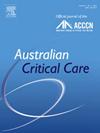A nurse practitioner service in an adult tertiary intensive care unit: A prospective observational evaluation
IF 2.7
3区 医学
Q2 CRITICAL CARE MEDICINE
引用次数: 0
Abstract
Background
The intensive care nurse practitioner (NP) role in Australia is not well described, and intensive care NP models of care and activities have not been well reported.
An intensive care NP service at an Australian tertiary referral hospital was implemented. This service included six core practice areas: case management, vascular access, procedural sedation, tracheostomy management, intrahospital transport of critically ill patients who required mechanical ventilation, and external ventricular drain removal.
Objective
The objective of this study was to describe the activities of an Australian intensive care NP service at an adult tertiary intensive care unit over a 1-year period.
Methods
Observational and activity data were prospectively collected for all patients who received treatment or care from an intensive care NP. Data were stored in a specific database and summarised using descriptive statistics.
Results
During the 12-month period, 606 patients received care from the service with 1738 episodes of care. In addition, 20 patients were case managed (equating to 300 h of NP time planning and managing ventilator and tracheostomy weaning), 306 intravascular devices were inserted (complications: 1, 0.3% [95% confidence interval {CI}: 0.08–1.8%]), seven episodes of procedural sedation were administered (complications: 0), 62 episodes of tracheostomy care were provided, 33 external ventricular drains were removed (complications: 1, 3.0% [95% CI: 0.7–16%]), 324 intrahospital transfers were completed (avoidable complications: 0, 0% [95% CI: 0–1.1%]), and 72 episodes of supervision were provided by the NP for other clinicians.
Conclusions
The intensive care NP provided high volumes of advanced practice with low complication rates over a 1-year period. Implementation of an intensive care unit NP service has the potential to have positive impacts on workforce, capacity to train, and patient outcomes.
成人三级重症监护病房的执业护士服务:一项前瞻性观察评估。
背景:在澳大利亚,重症护理护士(NP)的角色没有得到很好的描述,重症护理NP的护理模式和活动也没有得到很好的报道。在澳大利亚一家三级转诊医院实施了重症监护NP服务。这项服务包括六个核心实践领域:病例管理、血管通路、程序性镇静、气管切开术管理、需要机械通气的危重病人的院内转运以及室外引流。目的:本研究的目的是描述澳大利亚重症监护NP服务在成人三级重症监护病房1年期间的活动。方法:前瞻性地收集所有接受重症监护NP治疗或护理的患者的观察和活动数据。数据存储在特定的数据库中,并使用描述性统计进行汇总。结果:12个月期间,606例患者接受护理,护理次数1738次。此外,20例患者进行了病例管理(相当于300小时的NP时间计划和管理呼吸机和气管造口机的脱机),306例植入血管内装置(并发症:1.0.3%[95%可信区间{CI}: 0.08-1.8%]),给予7次手术镇静(并发症:0),提供62次气管造口护理,33例室外引流(并发症:1.3.0% [95% CI]:0.7-16%]),完成了324例院内转院(可避免的并发症:0,0% [95% CI: 0-1.1%]),并由NP为其他临床医生提供了72次监督。结论:在1年的时间里,重症监护NP提供了大量的高级实践和低并发症发生率。实施重症监护室NP服务有可能对劳动力、培训能力和患者预后产生积极影响。
本文章由计算机程序翻译,如有差异,请以英文原文为准。
求助全文
约1分钟内获得全文
求助全文
来源期刊

Australian Critical Care
NURSING-NURSING
CiteScore
4.90
自引率
9.10%
发文量
148
审稿时长
>12 weeks
期刊介绍:
Australian Critical Care is the official journal of the Australian College of Critical Care Nurses (ACCCN). It is a bi-monthly peer-reviewed journal, providing clinically relevant research, reviews and articles of interest to the critical care community. Australian Critical Care publishes peer-reviewed scholarly papers that report research findings, research-based reviews, discussion papers and commentaries which are of interest to an international readership of critical care practitioners, educators, administrators and researchers. Interprofessional articles are welcomed.
 求助内容:
求助内容: 应助结果提醒方式:
应助结果提醒方式:


